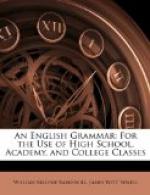Struggling for life,
each almost bursting their sinews to
force the other off.—PAULDING.
Whosoever hath any gold, let them break it off.—Bible.
Nobody knows
what it is to lose a friend, till they have
lost
him.—FIELDING.
Where she was gone,
or what was become of her, no one could
take upon them
to say.—SHERIDAN.
I do not mean that I
think any one to blame for taking due care
of their health.—ADDISON.
Exercise.—In the above sentences, unless both genders are implied, change the pronoun to agree with its antecedent.
RELATIVE PRONOUNS.
I. RESTRICTIVE AND UNRESTRICTIVE RELATIVES.
[Sidenote: What these terms mean.]
412. As to their conjunctive use, the definite relatives who, which, and that may be cooerdinating or restrictive.
A relative, when cooerdinating, or unrestrictive, is equivalent to a conjunction (and, but, because, etc.) and a personal pronoun. It adds a new statement to what precedes, that being considered already clear; as, “I gave it to the beggar, who went away.” This means, “I gave it to the beggar [we know which one], and he went away.”
A relative, when restrictive, introduces a clause to limit and make clear some preceding word. The clause is restricted to the antecedent, and does not add a new statement; it merely couples a thought necessary to define the antecedent: as, “I gave it to a beggar who stood at the gate.” It defines beggar.
413. It is sometimes contended that who and which should always be cooerdinating, and that always restrictive; but, according to the practice of every modern writer, the usage must be stated as follows:—
[Sidenote: A loose rule the only one to be formulated.]
Who and which are either cooerdinating or restrictive, the taste of the writer and regard for euphony being the guide.
That is in most cases restrictive, the cooerdinating use not being often found among careful writers.
Exercise.
In the following examples, tell whether who, which, and that are restrictive or not, in each instance:—
[Sidenote: Who.]
1. “Here
he is now!” cried those who stood near
Ernest.—HAWTHORNE.
2. He could overhear
the remarks of various individuals, who were
comparing the features
with the face on the mountain side.—Id.
3. The particular
recording angel who heard it pretended not to
understand, or it might
have gone hard with the tutor.—HOLMES.
4. Yet how many
are there who up, down, and over England are
saying, etc.—H.W.
BEECHER




